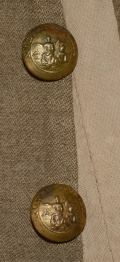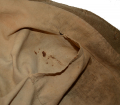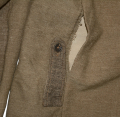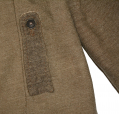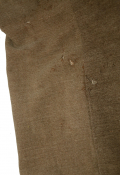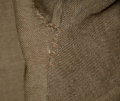site search
online catalog
WORLD CLASS IDENTIFIED WOUNDED IN ACTION CIVIL WAR NORTH CAROLINA SOLDIER’S JACKET WITH BULLET HOLE FROM HIS WOUND AT THE WILDERNESS!
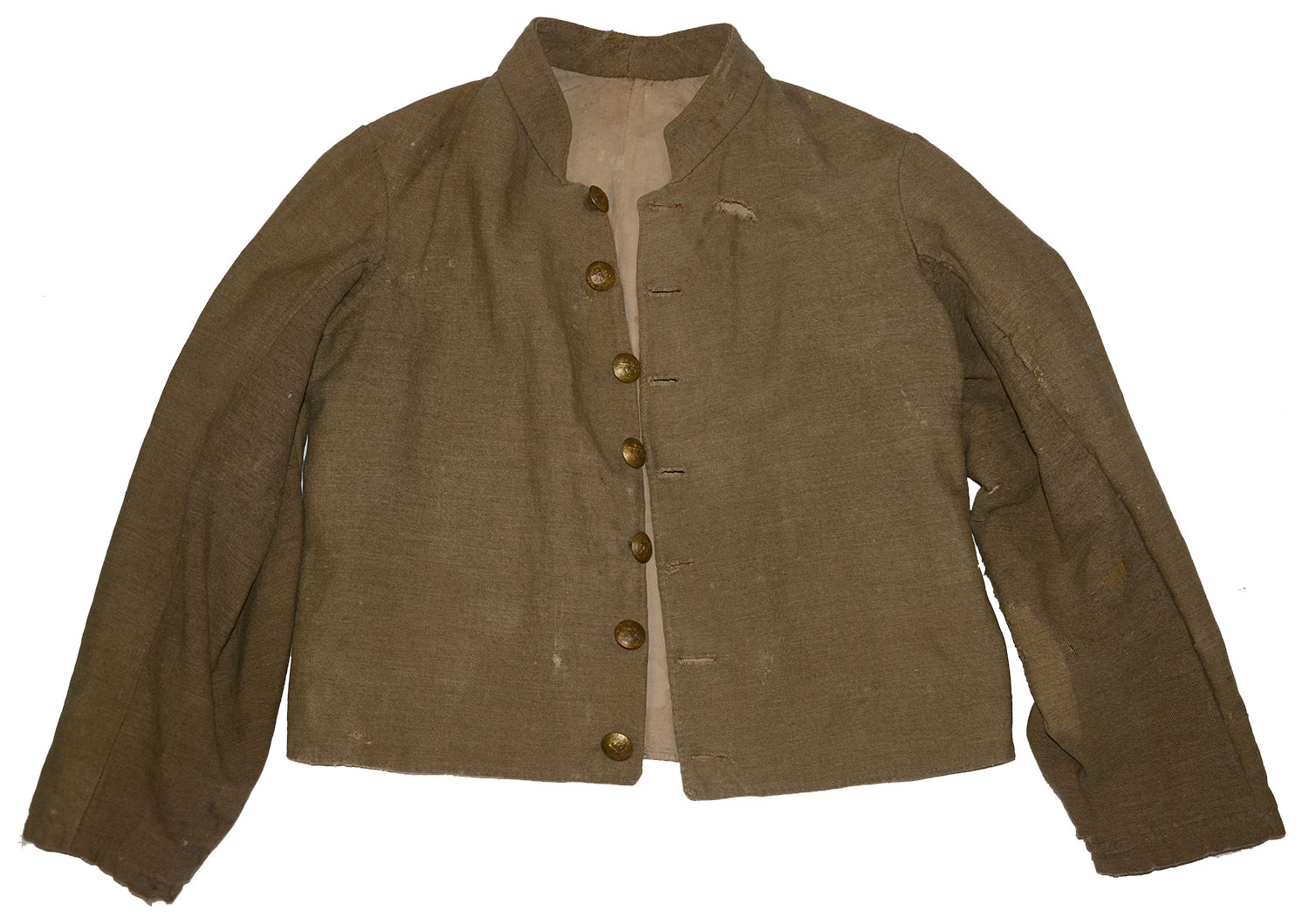
$65,000.00
Quantity Available: 1
Item Code: 814-69
Shipping: Determined by Method & Location of buyer
To Order:
Call 717-334-0347,
Fax 717-334-5016, or E-mail
Formerly in the collections of the Texas Civil War Museum this world-class Confederate infantryman’s jacket worn by William B. Royal came directly out of the family in 2002, having been previously examined and recorded in 2000 while still in the hands of descendant Howard “Hardy” Lee Royal. The jacket still shows the bullet hole in the upper left chest W.B. Royal suffered at the Battle of the Wilderness May 5, 1864, producing a shoulder wound that sent him home to recover, and from which he returned to service, to be captured at Hatchers Run, April 1, 1865, in the final stages of the fighting around Petersburg.
The jacket is made with a 4-piece body and 2-piece sleeves. It has a standing collar 1-¼” inches tall at the back center and 1-½” with sloping front edges. It has a seven-button front and two belt loops on the back about 4-3/8” long, sewn at the bottom and buttoning at the rounded top, tapering slightly from about 1-1/4” at the bottom to 1” at the top. The fabric was described as “homespun” by one dealer who handled it after it left the family, but a more knowledgeable textile person who examined while still in family hands described it as a “fine woolen jean with a very slight olive tint on a brown cotton warp.” They also noted the mixture of dye lots with the jacket and, “a mixture of different hand stitching which appear to be from different individuals working on the jacket. These characteristics seem to indicate that this jacket was part of a mass production rather than a jacket which was cut and sewn for an individual out of a single piece of cloth” and note the use of seven buttons on a North Carolina identified jacket is “slightly atypical,” but not unknown in wartime photographs of North Carolina soldiers. The interior is lined in the body and sleeves in an off-white linen and has a large open-top patch pocket in the lower chest on each side.
As will be seen in Royal’s service record summarized below, after a long sick leave he returned to active duty April 7, 1864 and was wounded in action just a few weeks later, after which he received a sick leave to return home and recover, returning to duty again about mid-September. The jacket was clearly a recent issue to him just before or just after returning to the regiment the first time. The jacket shows just some slight wear around the lower edge and slight bit at back of the collar, but not around the cuff edges, etc., indicating he had not had it long before his wounding. The bullet hole seems to indicate he was struck by a ball coming at angle from his front right- the hole is about 3/8” wide and 1-1/2” long on the upper left chest about level with the first buttonhole, indicating the ball plowed into his left shoulder. In treating the wound the front seam of his left sleeve was cut open to give access to it, or simply make it easier to get the jacket off him. The lower portion of the sleeve shows a large slightly yellowish patch that seems clearly to be the remains of a bloodstain and the little scattered moth damage there is to the jacket is also concentrated in this area, the moths clearly attracted to the remnants of the blood though the family, Royal’s nurses, or Royal himself tried to wash out the blood. That the seam of the sleeve was left open may have been to enable him to wear his arm in a sling while recovering from the shoulder wound. Royal was a sergeant when wounded and we do not see indications of chevrons on the jacket, though they may have been carefully removed like the buttons as souvenirs or mementos by family members. More likely he simply had no time to obtain or fashion chevrons in the short time he had the jacket between returning to duty and being wounded. Royal’s compiled service records include mention of his name on several clothing receipts at various dates. The items are not specified, and we can’t say the list is exhaustive, but we do note his signature appeared on a “receipt roll for clothing issue to soldiers in Jackson Hospital at Richmond, Va.,” with a date of issue of April 6, 1864, the day before he was returned to duty- so it is very possibly this jacket.
When the jacket was examined in 2000 while still in family hands, there were no buttons on the front and just one of the four-hole commercial buttons for the belt loops. After its acquisition by a dealer in 2002 it underwent some conservation: the left sleeve seam that had been opened was closed up for better display, seven original, wartime North Carolina buttons (possibly by S.A. Myers) were restored to the front, and the missing belt tab button was replaced. A few other short openings of seams, etc., were closed or holes backed, likely for the sake of stability of the garment, etc., but there were no alterations or additions we can see other than the buttons. We note that the rear left seam on the back has opened for a short distance and should probably be closed up again.
William B. Royal was born Dec. 26, 1841 and in the 1860 was listed as age 18, working on the family farm in Honeycutts, Sampson County, NC, and living with his father, mother and six siblings. On October 18, 1861, he enrolled in a company of volunteers calling themselves the “Sampson Farmers” (one of the least pretentious nicknames for a military company we can think of) at Bennett’s Crossroads in Sampson County, North Carolina, listing himself as a farmer by occupation and 19 years-old. The company became Co. C of the 38th North Carolina Infantry, officially organized at Camp Mangum, near Raleigh, for one year’s service, on January 17, 1862, with Royal mustered in the day before as the company’s 2nd Sergeant. Their term of service was extended to “for the war” on April 18 and a new election of officers held. Whether there was also a new election of NCOs is unclear, but Royal remained as 2nd sergeant, likely an indicator of some social standing in the community, or just an imposing figure since he stood 5’11” tall.
Royal is present on all extant company muster rolls until being marked “absent sick” starting June 10, 1863, and absent sick in hospitals in Charlottesville and Richmond from June 20, 1863. A note in his file indicates he was hospitalized at Lynchburg for “debility” in November 1862, but for how long is unclear and he is present on the company Nov-Dec 1862 roll, so it cannot have been long. Up until his hospitalization in June 1863 the unit had been part of Anderson’s and then Gregg’s brigade and had been guarding railroad bridges near Guinea Station, Virginia, until June 1862. It then joined Pender’s Brigade, fighting on the Peninsula in the Seven Days Battles, losing 152 out of 420 on the field at Beaver Dam Creek, with further action at Gaines Mill and Frayser’s Farm, followed by service at Cedar Mountain, 2nd Bull Run (with 2 killed and 22 wounded,) the siege of Harpers Ferry, Antietam (where they were lightly engaged,) Shepherdstown, Fredericksburg (14 wounded,) and Chancellorsville, where they lost 20 killed, 77 wounded, and 11 missing.)
Royal’s sickness in June 1863 seems to have kept him in several hospitals in Richmond, suffering from “debility” and bronchitis, for ten months until he was returned to duty on April 7, 1864, from the Jackson Hospital in Richmond, again appearing on his company’s March-April 1864 muster roll, though listed as “present sick.” This did not keep him from taking the field, however, for less than a month later he was wounded at the Wilderness on May 5, 1864, where the regiment (part of Scales’s Brigade of Wilcox’s Division of Hill’s 3rd Corps) fought near the Chewning house and the Widow Tapp farm, and along Poplar Run south of the Orange Plank Road, having become separated from Scales’s brigade and fought as part of Lane’s.
Muster rolls indicate Royal was sent home to recuperate, at least by the time of the completion of the May-June 1864 muster roll. He was apparently due back on duty by August 10, 1864, and was reported as Absent Without Leave as of that date, but is back by the September-October roll, though listed as a private, with pay due as a sergeant only up to Sept. 12. That date likely marks his reduction to the ranks, perhaps for his absence without leave or just to make room for someone else’s promotion. In any case, he was thus present for the regiment’s service in the siege of Petersburg and fighting at Fort Harrison, Jones’s Farm, and the February battle at Hatcher’s Run. He was captured just two months later at or near Hatcher’s Run on April 1, 1865, in the final fighting around Petersburg that included fighting at Dinwiddie Courthouse and Five Forks, and sent to City Point, arriving on April 2, the day of the final assault on the city, and was interned there until released on June 19.
Royal returned to Honeycutts and Sampson County, where he shows up as a farmer in the 1870 and 1880 census. He married in 1866 and fathered at least nine children. He died June 15, 1902, and was interred at Goldsboro, from where his wife applied for a pension in 1908.
This is remarkable relic of the war- not only a Confederate infantry jacket, but an identified infantry jacket with tight provenance to the family, to a soldier wounded in action, and the jacket he was actually wearing when wounded in one of the fiercest battles of the war where Lee managed to halt Grant’s direct advance, but started his process of “side-slipping to the James,” the siege of Petersburg and eventual end of the war, which the soldier had returned to service in time to witness. [sr][ph:L]
~~~~~~~~~~~~~~~~~~~~~~~~~~~~~~~~~~~
THIS ITEM, AS WITH ALL OTHER ITEMS AVAILABLE ON OUR WEB SITE,
MAY BE PURCHASED THROUGH OUR LAYAWAY PROGRAM.
CLICK HERE FOR OUR POLICIES AND TERMS.
THANK YOU!
Inquire About WORLD CLASS IDENTIFIED WOUNDED IN ACTION CIVIL WAR NORTH CAROLINA SOLDIER’S JACKET WITH BULLET HOLE FROM HIS WOUND AT THE WILDERNESS!
For inquiries, please email us at [email protected]
Most Popular
Historical Firearms Stolen From The National Civil War Museum In Harrisburg, Pa »
Theft From Gravesite Of Gen. John Reynolds »
Selection Of Unframed Prints By Don Troiani »
Fine Condition Brass Infantry Bugle Insignia »
British Imported, Confederate Used Bayonet »
Scarce New Model 1865 Sharps Still In Percussion Near Factory New »
featured item
IMPORTANT IDENTIFIED AND CAPTURED CONFEDERATE LIMBER/CAISSON CHEST
Initially one should be aware that limbers carry one ammo chest, caissons carry two. Caissons carry a spare wheel, limbers do not. Limbers are pulled by horses and can be attached to a gun and or a caisson. Caissons are not affixed directly to… (2025-297). Learn More »
site search
Upcoming Events
May 16 - 18: N-SSA Spring Nationals, Fort Shenandoah, Winchester, VA Learn More »






